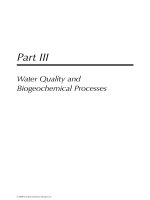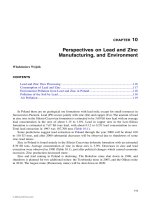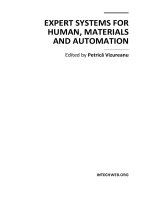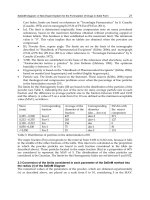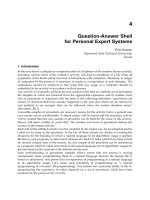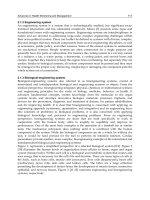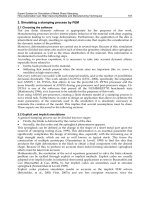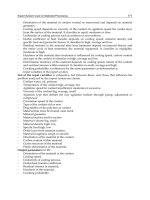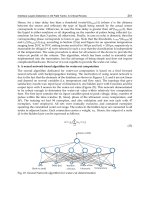Expert Systems and Geographical Information Systems for Impact Assessment - Chapter 10 potx
Bạn đang xem bản rút gọn của tài liệu. Xem và tải ngay bản đầy đủ của tài liệu tại đây (1.14 MB, 40 trang )
10 Water impacts
10.1 INTRODUCTION
We have discussed in some detail a wide range of types of impacts, reducing
them to relatively simple logical processes with a potential for automation
as expert systems. Although not all the standard areas of impact assess-
ment have been covered, there has been enough variety to illustrate most
and judgement into a simple logical process that a non-expert can follow.
This can be illustrated by discussing one last area of impact that encom-
passes most of the issues raised in other areas: water, which really consists
of a succession of several impact assessments. Water impact assessment is
probably the most difficult, because of the extreme variety of impacts that
can affect water, and because of the extreme variety of standards and
said that Environmental Impact Assessment is a by-product of the relative
cultural sophistication normally associated in a society with a certain
degree of development, but concerns with the quality and quantity of
water have been central to all societies throughout history, and this makes
it probably the most extensively documented – and regulated – area of
impact assessment. Also, in terms of the line of argument we are following
here, water impact assessment involves really a chain of several areas of
impact, each of which can be looked at as we have been doing in previous
chapters. These areas can be seen as “modules” which form part of
water impact assessment, linking the original source of impacts – the
project – to the ultimate impacts on humans or on the natural environment
•
The project can produce certain effects directly on a water system
(discharges to it, abstractions from it) and it can also have certain
effects on the groundwater.
•
The behaviour of the groundwater will determine possible indirect effects
on water systems, as well as other effects on the soils and on the usage
© 2004 Agustin Rodriguez-Bachiller with John Glasson
legislation covering them (see Bourdillon, 1995 for an early list). It can be
of the problems and issues involved when “translating” expert behaviour
(Figure 10.1).
318 Building expert systems for IA
of water as a resource; in impact assessment, these impacts are usually
covered under headings like “hydrogeology and soils”.
•
Be it directly or indirectly, the water system is affected in terms of
“water quality/quantity”: volume, flow and possible contamination.
•
In turn, the water system affected has effects (impacts) on the usage of
water as a resource (for drinking, leisure, etc.) and on the ecology of its
environment.
•
Usually, water ecology impacts are studied under one of two headings:
“freshwater ecology” (rivers and lakes) and “coastal ecology” – with a
third category of “estuarine ecology” used sometimes – depending on the
type of water system.
We can treat the study of water impacts as a sequence of impact studies,
from hydrogeology to water quality to ecology. As already mentioned, the
literature on each of these areas is vast, and impact assessment manuals can
be good summaries of the field (like the very detailed account in York and
Speakman, 1980) and can also provide good “guides” to the literature
(Westman, 1985; Petts and Eduljee, 1994a and 1994b; Atkinson, 1999;
Biggs et al., 2001; Hodson et al., 2001; Morris et al., 2001d; Thompson and
Lee, 2001). It is also an area with much legislation and regulation,
the latest of which being the EC’s Water Framework Directive (EU,
Figure 10.1 The interlinked logic of hydrogeology, water, and water-ecology
impacts.
© 2004 Agustin Rodriguez-Bachiller with John Glasson
Water impacts 319
2002).
46
Here, we are going to follow the same logic as before, discussing
each of the main steps in the flow chart above, and treating in greater depth
each of the specific areas of impact study.
10.2 THE PROJECT
Since we are looking for both “direct” effects and “indirect” effects (through
hydrogeology) on all the water systems around the project (surface or
underground), we are interested in those aspects of the construction or
operation of the project likely to generate such effects. For the construction
stage, the list concentrates on the type of project it is and its features on the
one hand, and on construction practices on the other (for reasons that will
become clear later, we are marking with an asterix * those aspects with
a link to hydrogeology):
1 The type of project and the presence/absence of certain features may
involve:
•
tunnelling or mining (*);
•
quarrying or deep excavations involving soil removal (*);
•
site-levelling involving earth movements (*);
•
foundations involving piling (*);
•
temporary modification or manipulation of water systems, changes
in the course of a river, erection of water-protection barriers;
•
construction of drainage systems (*).
2 Concerning on-site working practices:
•
number of workers;
•
phasing of construction;
•
materials used for construction;
•
policy concerning the control of dust and particulates by vehicle
and earth movements;
•
vehicle movements, and the type of fuel to be used (especially
diesel);
•
on-site policies about storage of fuel and oil tanks and dealing with
losses and leakages (*);
•
policy about disposal of empty fuel and oil tanks (*).
© 2004 Agustin Rodriguez-Bachiller with John Glasson
46 Also available as a consultation document circulated by the UK’s Environment Agency on
the internet in page />?versione1&lang = _e or by e-mail from waterframeworkdirective@environment-agency.
gov.uk.
320 Building expert systems for IA
During the operation stage of the project, the presence of any features
which could alter or contaminate the water systems may include (* indicates
a link to hydrogeology):
1 project areas: area affected, area paved (*);
2 number of persons using the site: workers, customers/visitors, suppliers;
3 what facilities are included in the project: canteens, toilets, water-
related facilities like swimming pools;
4 concerning the discharge of foul water from the project: connected to
existing sewers, a new sewer (*);
5 storage tanks (*):
(a) their contents,
(b) their location: above ground, below ground;
6 pipelines and their location (*): above ground, below ground;
7 other discharges apart from foul water from toilets and kitchens:
(a) composition of the discharges: materials, chemical composition,
flow rate, temperature,
(b) concentration: from a point source, diffuse,
(c) location of the discharges:
(i) to a water system, are there balancing facilities (like a pond)
before the release outside? (*),
(ii) to the ground (*): as run-off water, to soak-aways.
8 water abstractions:
(a) from a surface water system,
(b) from bore-holes from underground aquifers (*),
(c) flow/volume required.
This list is really a combination of the individual lists we would require if
we were studying hydrogeology, soils or ecology, which overlap considerably
with each other. How to proceed next is dictated by the project features
present. In the first place, the list of project features can show that the
project will discharge to (or abstract from) a surface water system directly
(and we can study these impacts on the water), or that it will discharge to
the ground or affect the ground in other ways (earth-movements, etc.). If
the latter is the case, these ground-related actions can produce two kinds of
impacts to be studied separately: (i) impacts on the soil itself, which we
would study as a separate area of impact assessment; (ii) impacts on the
hydrogeology beneath it, which we also study as another area of impact
assessment, and finally, the hydrogeological effects in turn are likely to
This discussion does not cover Soil impact assessment, because the focus
is on direct or indirect impacts on water. Soil impacts merit a whole section
© 2004 Agustin Rodriguez-Bachiller with John Glasson
impact on the surface water system (Figure 10.2).
Water impacts 321
of their own (they usually do in manuals and in Environmental Statements)
involving baseline studies, impact identification, standards, mitigation, etc.
Good-practice guidance on soil impact assessment can be found in Petts
and Eduljee (1994a), Hodson (1995) and Hodson et al. (2001), which also
contain references to government guidance and standards.
The focus of our hypothetical study of impacts here depends on what
features are present in the project and whether they are likely to produce
direct or indirect impacts on water: (i) if the project has features that
suggest there are likely to be hydrogeological issues involved (indicated by
the presence of project features marked *), we proceed to the study of
hydrogeological issues; (ii) if the hydrological effects from the project are
only direct ones to a surface water system, we can move on directly to
study water quantity and quality in those systems (Section 10.4 below).
10.3 HYDROGEOLOGY: THE BASELINE
Hydrogeology – often studied together with “soil” – is another typical
area of impact assessment, and it follows a logic similar to the others,
from the baseline study to the determination and mitigation of impacts
information (Simonson, 1994),
47
and only rarely – for big projects with
a big budget for the impact study – does it involve fieldwork to collect
information. As this process evolves, the area of study also changes,
47 The knowledge acquisition for this part was greatly helped by conversations with John
Simonson, of Environmental Resources Management Ltd (Oxford branch); Mathew Anderson
helped with the compilation and structuring of the material for this part. However, only the
author should be held responsible for any inaccuracies or misrepresentations of views.
Figure 10.2 The chain of project effects on soil, hydrogeology and water.
© 2004 Agustin Rodriguez-Bachiller with John Glasson
into an exercise in consultation with organisations that have the relevant
(Figure 10.3). The baseline study develops from a map-based desk study
322 Building expert systems for IA
focusing gradually on the site, so that the baseline study is really applied
at several spatial scales (regional, intermediate, immediate), which also
correspond to three time scales, as the diffusion of effects through
groundwater is quite slow.
At a regional scale, the geological setting is studied with geological and
hydrological maps (some of them also available in digital form)
48
from the
British Geological Survey, at what could be seen as the scale of very long-
term effects. The aim is to build a mental model of the geological structure
48 British Geological Survey operates an online “Geoscience Data Index” of all the data and
maps they hold (Hodson
et al.
, 2001) in digital form, and the Centre for Ecology and
Hydrology in Wallingford also has produced the National Groundwater Level Archive
2001).
Figure 10.3 The logic of the hydrogeological baseline study.
© 2004 Agustin Rodriguez-Bachiller with John Glasson
(CEH, 2000) with map-information about wells and major aquifers (see Morris et al.,
Water impacts 323
on which the project site will impact. Such model can be a variation of the
simplest hydrogeological model (Morris et al., 2001d) where there is a
standard series of geological strata below the project:
•
a thin layer of organic soil at the top;
•
next, a thicker layer of more or less permeable sub-soil (clay, sand, gravel);
•
then, an impervious bedrock layer below.
An aquifer may be present in the second layer, saturating it in water up
to a certain level, the water table. When aquifers are present, they can be in
direct contact with the rest of the upper layer (“unconfined” aquifers) or
they can be “confined” by a layer of impervious material above them which
can also protect them from penetration and contamination.
The main focus of this stage of the study is to identify the various layers –
organic soil at the top, sub-soil, bedrock, and intermediate “confining”
layer if it exists – under and around the site:
•
type of sub-soil (clay, gravel, sand), thickness;
•
type of bedrock beneath it: depth, other types of bedrock in the area;
•
type and thickness of any confining layers;
•
presence of special geological features: faults/fissures, foldings.
The depths and slopes of the different layers will give an idea of the
direction in which the bedrock is “dipping”, and whether this is an area of
geological complexity or one which can be treated as a standard case. The
latter would have the same layers superimposed all over the project area,
no discontinuities (changes in the type of layer, or breaks in the structure),
and the project not near any edge between layers where vulnerable points
may appear. The ultimate aim of the study is to get a picture of how
any groundwater present is likely to move and “carry” any possible
contaminations:
1 Identifying the presence and type of aquifers (one or several) under the
area of study:
(a) the depth of the water-table;
(b) the depth of the aquifer;
(c) determining if the aquifer is protected by other hard layers (gravel
for instance), especially from above.
2 Most importantly, anticipating the likely movement of groundwater:
(a) the likely direction of flow of groundwater, derived from the way
the bedrock underneath slopes;
(b) where it is likely to discharge to a water system.
© 2004 Agustin Rodriguez-Bachiller with John Glasson
324 Building expert systems for IA
Geological data will normally come mainly from already-prepared maps
(Simonson, 1994), but much of this information can also be obtained
through field surveys. Such surveys can come from previous studies of the
same area or can be commissioned by the project developer – if the time and
budget for the study permits. Field surveys usually involve a combination of:
•
sampling of the location of the survey-points;
•
thin bore-holes to extract samples from all the layers which can be
measured and analysed;
•
wells for the analysis of aquifers, the water table and water quality.
Whatever the source of the data, the derivation from it of a mental
“model” of the geology of the area draws on the considerable complexity
of geology as a science, and can present the same type of difficulty for auto-
mation (for an expert system) that was encountered for ecology: the
complexity of the science behind the expert’s approach, which he/she will
need to refer to when the case in hand is “non-standard”. On the other
hand, the prediction of directions of flow for standard situations can be
made easier by automation using GIS if the geomorphology maps are in
digital form and include depth and thickness of strata. Using such maps in
conjunction with Ordnance Survey maps, standard GIS Digital Terrain
Models can be built, from which slopes and directions of flow of potential
streams can be derived for any of the geological strata included in the GIS
maps.
At an intermediate scale, an area of possible medium-term impacts around
the project (2 km around the site, which could take 10–20 years for
groundwater to reach) is studied to identify potential receptors in the area,
the types of users of groundwater in the area, including: industrial, residential,
leisure, other uses. Ordnance Survey maps can be used, as well as surveys
carried out by the Local Authority.
The general objective of the baseline study is to establish the site’s vulner-
ability (Simonson, 1994). At one extreme, if the clay is very thick (50 m) the
aquifer below is well protected; at the opposite extreme, if the water table
is high, there is no protecting hard layer, and the aquifer is used for public
water supply, then the situation is highly vulnerable. This vulnerability can
also be established in the UK from maps from the Environment Agency:
degrees of vulnerability are recorded in Groundwater Vulnerability maps
(at 1:100,000) produced in paper as well as digital format, and if the site
is in a Groundwater Source Protection Zones, on maps in digital form for
GIS use.
After the desk-study of maps (GIS-based or not), the baseline study
moves on to a consultation stage to complement the cartographic informa-
tion: (i) with the Local Authority, to find out if it is a Regionally Important
Geological site; and (ii) especially, with the UK’s Environment Agency (or
equivalent in other countries):
© 2004 Agustin Rodriguez-Bachiller with John Glasson
Water impacts 325
•
to find out the degree of vulnerability of the area as a: major aquifer,
minor aquifer, non-aquifer;
•
to learn what abstraction licenses there are in the area: location, volume,
type of use;
•
and also, to ascertain the Agency’s general views about the area and if
they have any concerns about groundwater quality.
At the next scale down, potential receptors in the immediate surround-
ings of the site (100–500 m) are considered, where the effects from the site
could permeate in a short time. Finally, the site itself is studied in its geolog-
ical structure in the greatest detail possible with the available information,
as it is there that the project will produce the impacts (rupturing a layer
of clay, reaching an aquifer, etc.). Sometimes, the project has required a
geological survey by the developer before assessing its feasibility and deter-
mining its structural requirements (foundations, etc.). When this is the case,
the geo-technical reports for that survey of the site and adjacent areas are
another invaluable source of baseline information.
An important part of the baseline study of the site and the surrounding
area is a historical investigation, based on consultation with the Local
Authority and/or the local library:
•
study of previous landuses, in case there have been previous possible
contaminations of the land/aquifers (if industry has been present on or
around the site);
•
historical waste-disposal practices in the area.
The aim is to estimate the likelihood of historical contamination of the
area, which is expensive to measure directly with boreholes.
10.3.1 Hydrogeological impacts
A comprehensive list of all types of water impacts (not just hydrogeological)
can be found in Morris et al. (2001d), and Hodson et al. (2001) discuss
a short list of more specifically hydrogeological effects. In general, such
effects fall into three main types, which in turn originate from different types
of project actions:
1Physical disruption of the geological setting derived from physical/
(a) alteration of some layers, in particular by extraction:
(i) for foundations,
(ii) for subterranean facilities.
© 2004 Agustin Rodriguez-Bachiller with John Glasson
structural features in the project (Figure 10.4):
326 Building expert systems for IA
(b) affecting the water table:
(i) exposing it after excavations,
(ii) reaching the water table,
(iii) piercing the “confining” layers.
(c) obstacles to groundwater flow, by subterranean facilities or foun-
dations, resulting in:
(i) obstructions,
(ii) changes in direction.
2 Impacts on the volume of groundwater:
(a) by reducing aquifer-recharges, typically by paving (or putting
tarmac) over land thus reducing the amount of water making its
way into the ground;
(b) by abstractions of water for project use;
(c) by changing the flow-pressure by emissions of water (even if clean).
3 Contamination of aquifers:
(a) during construction:
(i) accidental spillages of oils/lubricants or combustion fuels to
the ground,
(ii) non-accidental effluents derived from vehicle-washing,
(b) during operation:
(i) accidental spillages of oils/lubricants or combustion fuels to
the ground,
(ii) accidental spillages from liquids stored on site,
(iii) discharges of contaminated water from the project to “soaka-
ways” from which it may percolate to reach aquifers if the
geological setting allows it,
(iv) gradual discharges of leachates/contaminants from underground
projects like landfills.
Figure 10.4 Physical disruptions from the project.
© 2004 Agustin Rodriguez-Bachiller with John Glasson
Water impacts 327
The prediction of physical-disruption impacts is based on an initial qualitative
identification of the presence in the project of features with such potential
effects: excavations, subterranean structures, foundations and piling.
In addition to the presence of these features, some simple calculations have
to be made to establish if they are likely to constitute an impact. Practically
all projects involve the disturbance of the land and a certain amount of
excavation (and foundations work), but these operations will only impact
on hydrogeology if they affect an aquifer by going deep enough to “reach”
it. This can happen directly or by piercing other hard layers protecting it, or
even by piercing through the bedrock under it (providing new “escape
routes” for the groundwater). This possibility can be anticipated by compar-
ing the depth of each subterranean operation (from the project specifications)
with the depth of the aquifers, the water table and the bedrock layers from
the baseline study.
The other two types of impacts are determined in a more quantitative
way. Impacts on the volume of aquifers can be estimated as percentages of
the existing aquifer (Figure 10.5):
•
Concerning the loss of recharge land, the area lost can be compared to
the area of recharge-land above that section of the aquifer, and the
percentage loss can be calculated.
Figure 10.5 Impacts on the volume of aquifers.
© 2004 Agustin Rodriguez-Bachiller with John Glasson
328 Building expert systems for IA
•
Concerning the impact of abstractions, the volume of flow required for
the abstraction can be compared to the total flow in the aquifer under-
neath, and the percentage loss calculated in the same way.
•
Similar calculations can be made with respect to any emissions of
extra water into the aquifer, comparing its volume to the flow of the
aquifer.
With respect to the contamination of aquifers, its determination is also
predominantly quantitative, but it also can go through a simulation stage,
which can involve some modelling (Figure 10.6). Once the likely
discharges to the soil (intentional or accidental) have been determined,
the question is how the polluted water will travel: (i) how much of it will
reach aquifers through the soil (and eventually reach surface water
systems)?; (ii) how much will reach the water systems directly through the
surface?:
•
With respect to discharges and spillages on the surface, run-off models
can be used to separate the contaminated water likely to travel through
the surface from the water likely to filter through the soil. This separation
is expressed as the proportion of water likely to run-off (the “run-off
coefficient”) and Appendix C of Morris and Therivel (1995) show values
for this coefficient for a range of types of soil and landuses.
•
The behaviour of underground pollutants can be approached using
transport models, mostly produced in the US (a good review can be
Figure 10.6 Contamination of aquifers.
© 2004 Agustin Rodriguez-Bachiller with John Glasson
Water impacts 329
found in USEPA, 1988) like MODFLOW or AQUA, or even adap-
tations of air-dispersion models like ISC3.
49
•
For the particular case of land-fills, underground leachate leakages and
their behaviour can also be estimated using models which use the “release
rates” of different linings used for landfill projects (Petts and Eduljee,
1994b), models like LANDSIM (Hodson et al., 2001), or the Simplified
Vertical and Horizontal Spreading model researched in Britain by the
Department of the Environment (Eduljee, 1992).
•
Darcy-type models can be used to simulate the movement of contamin-
ated water through the soil. Darcy’s Law applies to groundwater
aquifers and it expresses groundwater velocity as proportional to the
“groundwater slope” (difference in hydraulic heads between two
points divided by their distance) and to the “hydraulic conductivity” of
the soil, whose value for different types of soil can be found in
published sources.
Such models can be used to estimate the flow of contaminants towards
the aquifers, which in turn will determine the level and speed of the
contamination and the resulting concentration of pollutants in the water at
the point of discharge into the water system. In addition to the speed of
diffusion of the contaminant, its density will also affect its behaviour
(Simonson, 1994), as a contaminant denser than water will travel through
the water table in a very different way to another less dense than water.
A comprehensive list of water models can be found in Morris et al. (2001d),
which also gives a cautionary note about their use, the difficulties they
present and how relatively expensive they are, maybe explaining the reason
why they are not used often (Simonson, 1994). In practice, modelling what
happens two kilometres away is an exception rather than the rule, and
hydrological impact studies tend to concentrate on the project-site and
immediate area and just comment on the potential effects for any sensitive
receptors in the area further away. Normally, a “generic” approach to the
impact study (no field-surveys and no modelling) is used – taking about
five person-days of work. Only if a particularly sensitive area is found,
is the developer asked to undertake a more detailed study (Simonson,
1994), on the grounds that the Environment Agency would not accept it
otherwise.
The standards for contamination of groundwater are quite fragmented
for various types of projects and are not very clear (Simonson, 1994). As
a result, the assessment of significance of impacts tends to be based on
judgement based on the vulnerability of the site – of the nearest groundwater
receptors – and the type of contaminant. Also, the Environment Agency has
© 2004 Agustin Rodriguez-Bachiller with John Glasson
49 Industrial Source Complex 3, by UK-Adams (see the section on air pollution in Chapter 7).
330 Building expert systems for IA
a framework that can be used for deciding on the acceptability of development
from the point of view of groundwater (EA, 1998).
10.3.2 Hydrogeological mitigation and monitoring
Impacts are produced directly by certain project features, hence mitigating
their effects involves modifying the project to varying degrees. At one end
of the scale, we have impacts produced by the “presence” of certain features,
and mitigating those impacts can only be done by avoiding/modifying those
features, involving some level of redesign of the project:
1 avoid piling if it would reach the water table;
2 avoid subterranean work or reduce depth;
3 in any earthwork involved, compliance with:
(a) British Standard 6031 (1981) “Code of Practice for Earthworks”
(b) British Standard 8004 (1986) “Code of Practice for Foundations”.
At an intermediate level, some mitigation measures involve slight modifi-
cations to the project – sometimes involving the choice of certain materials
over others – without modifying its fundamental design:
1 Measures to contain polluting substances:
(a) locating storage tanks and pipelines above ground;
(b) bunding of tanks in bunds with capacity greater (110 per cent for
instance) than the capacity of the tanks;
(c) placing storage tanks over impervious surfaces;
(d) placing diesel/petrol powered fixed plant on impervious drip-trays.
2 Measures to reduce run-off and increase underground recharge:
(a) removing as little vegetation as possible, and using replanting;
(b) using gentle gradients in the terrain rather than steep slopes;
(c) using porous surfaces when paving the ground.
3 Surface-flow retention measures:
(a) detention/balancing ponds
(b) grass swales
(c) vegetated channels.
4 Better drainage:
(a) routing all waste water to sewers or treatment works;
(b) site-drainage control to reduce polluted run-off;
(c) routing the drainage through siltation wells/lagoons to allow sedi-
mentation of solids;
(d) using oil-interceptors before the drainage leaves the site, correctly
dimensioned for the volumes of drainage and of rainfall expected
(sufficient volume and sufficient retention time).
© 2004 Agustin Rodriguez-Bachiller with John Glasson
Water impacts 331
Finally, at the other end of the scale, there is mitigation that involves just
improved site management measures, during both construction and operation,
including:
1 lining excavated areas;
2 minimising leachate generation;
3 guarding against spillages/leaks or accidental discharges;
4 compliance with:
(a) British Standard 6031 (1981) “Code of Practice for Earthworks”,
(b) British Standard 8004 (1986) “Code of Practice for Foundations”.
Most of these mitigation measures do not eliminate the impacts but only
reduce their effect in a “gradual” way, and this is why monitoring is an
essential part of mitigation if potential impacts have been identified
(Simonson, 1994). A groundwater-monitoring network should be installed
to detect changes in groundwater flow or chemical composition. The mon-
itoring stations should be located on the perimeter of the site: monitoring
measurements should be taken at least yearly (preferably quarterly); and
this monitoring should continue indefinitely, until monitoring reveals no
leakages over several years.
10.4 WATER QUANTITY AND QUALITY: THE BASELINE
Whether the “route” from the project to surface water-systems is direct or
indirect (through hydrogeology) the study of the effects on the water itself
is an essential part of any impact study near a water system, in relation to
both water quantity and water quality (Clarke, 1994).
50
investigated in relation to the project: (i) first, if the project relates directly
to a water system (by using it, discharging to it, or abstracting from it), that
water system must be included; (ii) second, any water system within a dis-
tance such that the effects of the project may affect it (through the surface
or underground) must also be investigated. The latter can be derived from
astudy of catchment areas:
•
Water-catchment areas for surface water systems can be worked out
with GIS using a Digital Terrain Model or a “surface” and basin-
analysis functions available in sophisticated systems (like Arc-Info
GRID).
Resources Management Ltd (Oxford branch); Owain Prosser helped with the compilation
and structuring of the material for this part. However, only the author should be held
responsible for any inaccuracies or misrepresentations of views.
© 2004 Agustin Rodriguez-Bachiller with John Glasson
50 The knowledge acquisition for this part and the “Freshwater ecology” part (see Section
10.5 below) was greatly helped by conversations with Sue Clarke, of Environmental
The first question (Figure 10.7) is to identify the water systems to be
332 Building expert systems for IA
•
The boundaries of all catchments in the UK greater than 0.5 km
2
are
included in the CEH CD-ROM database (CEH, 1999b) described in
Morris et al. (2001d).
If the project is inside the catchment area of a water system, that system
should be included in the study. The area of study can be estimated by similar
considerations to those for estimating areas around the project for the
hydrogeological baseline:
•
For short-term effects, any water system within 500 m of the project is
worth investigating.
•
For medium-term effects (several years), that distance can be extended
to 2 km.
These limits can be extended if there are particularly sensitive systems
a little further away, based on consultation with the Environment Agency.
Figure 10.7 The water baseline study.
© 2004 Agustin Rodriguez-Bachiller with John Glasson
Water impacts 333
Considering each water system in turn, the baseline study looks first at
the hydrological situation in terms of water quantity, based on recent data
(at least the last 3 years):
•
river flow data: yearly maxima, yearly minima;
•
rainfall in the area;
•
soil type: on the banks of the water system, between the water system
and the project;
•
run-off flow.
The information is obtained mainly from the Environment Agency. Rainfall
data can be obtained from the FEH CD-ROM database (CEH, 1999a)
from the Centre for Ecology and Hydrology (their National River Flow
Archive), or from the Meteorological Office. Run-off can be calculated by
modelling, using run-off models like PC-IHACRES for the UK, from the
centre for Ecology and Hydrology (Morris et al., 2001d).
The second area of baseline study is water quality, which is normally
monitored by the Environment Agency leading to a nationwide classification
by the National Water Council of all water systems into different “classes”
of quality. Water quality is normally studied based on physico-chemical
and biological considerations. The physico-chemical approach is a quantifi-
cation of the physical and chemical contents of the water system, and
normally relies on the Environment Agency, which regularly monitors rivers
and canals for their “General Quality Assessment”, looking at levels of:
Biochemical Oxygen Demand (BOD), Dissolved Oxygen (DO), ammonia,
some nutrients. To complement this data, other sources can be used to
measure indicators from an “ideal” checklist of substances and characteris-
tics including (Morris et al., 2001d):
•
nutrients (phosphorus, nitrate, chlorophyll A);
•
Dissolved Oxygen;
•
organic matter (BOD);
•
sediment;
•
metals;
•
oils;
•
other pollutants (Ammonia, Hydrogen sulphide, Cyanide, Pathogen from
faecal contamination);
•
acidity and pH;
•
alkalinity;
•
electrical conductivity;
•
temperature.
Surveys can also be used, although they can be expensive if the sampling
is extensive. So-called “grab” samples at one point are simple enough, but
to get good average values for the whole body of water it is better to use
© 2004 Agustin Rodriguez-Bachiller with John Glasson
334 Building expert systems for IA
composite samples based on “3-D systematic” sampling that can require a
substantial number of sampling stations.
The extent of pollutants covered in the baseline study should depend on
the types of discharges anticipated (York and Speakman, 1980):
•
if certain chemicals are to be discharged, those same chemicals should
be studied;
•
if nutrients are to be discharged, nitrogen, phosphorus and BOD
should also be studied;
•
if the project involves thermal discharges, the temperature must be studied;
•
if organic waste discharges are anticipated, oxygen resources must be
analysed (BOD, DO, temperature);
•
if sanitary sewage is to be discharged, total coliforms and fecal coliforms
must be measured;
•
if dissolved solids will be discharged, such solids should be measured as
well as conductivity, alkalinity, acidity, pH;
•
if suspended solids will be discharged, such solids should be measured,
as well as sediments.
The baseline study normally uses Environment Agency monitoring data
for the previous three years – because this span fits well the normal life span
of aquatic invertebrates – which are also used for the baseline assessment
(see below). If the water system involves fisheries or the water is particularly
pristine, the time span for data collection can be extended back to five (or
even ten) years.
Because chemical methods of water quality assessment are limited and
have problems, it is very common to use biological indicators instead, on
the basis that looking at the species – and their concentration – that survive
in the water can tell us most of what we want to know about its pollution
levels. The most common biological indicator is the presence of macroin-
vertebrate families that are regularly monitored by the Environment Agency.
It can be said that while water samples tell us about quality at a spot-point
in time, invertebrates give a longer-term picture of what the environment is
like (Clarke, 1994). If monitoring data is not available, surveys can be
undertaken, using simple methods like “kick” sampling walking along the
water course with a “sweep net” collecting the sample.
51
As discussed in
Morris et al. (2001d) the concentrations of invertebrates and the various
indices calculated from them are not sufficient indicators of water quality.
To establish the baseline quality of the water we should compare its situation
with a hypothetical “clean” case, and we can do this with a simulation model:
51 The Freshwater Biological Association has produced useful “identification keys” for
aquatic invertebrates.
© 2004 Agustin Rodriguez-Bachiller with John Glasson
Water impacts 335
•
Use the RIVPACS model (Morris et al., 2001d) to simulate the various
indices of invertebrate presence for the hypothetical “clean case” of
a water system of similar characteristics.
•
Compare such indices with those calculated from the baseline data for
the system in question, this should give good indicators of baseline
water quality.
In addition to studying the water quality in itself, to put the project in
context it is useful to know of any discharges by other activities (like
waterworks, or other developments) near the project or upstream from it,
in consultation with:
•
the Internal Drainage Board;
•
the Local Authority;
•
British Waterways (if it is a canal);
•
the Water Authority.
After water quantity and quality, the baseline study should look at
current water use (often referred to as “water as a resource”) under three
main headings:
1 abstractions:
(a) volume,
(b) type (potable, industrial).
2 fisheries:
(a) species,
(b) abundance,
(c) whether it is for exploitation or for fishing.
3 uses of the water:
(a) frequency/intensity of use,
(b) type:
(i) transport,
(ii) leisure: boating, water-contact sports (bathing/swimming,
water skiing, wind surfing), angling.
The water-use baseline can often be forecast by using trends. However, for
water quality, it is important to anticipate changes by, for example, asking
the Environment Agency about any plans to upgrade the quality level of the
water system, and the Local Authority about other projects in the pipeline.
10.4.1 Water quantity impacts
The project can affect the quantity of water in various ways, more or less
direct:
© 2004 Agustin Rodriguez-Bachiller with John Glasson
336 Building expert systems for IA
1The most direct influences:
(a) abstractions,
(b) discharges.
2At an intermediate degree of directness, run-off flow can be affected by:
(a) paving,
(b) planting,
(c) changes in the shape of the ground surface.
3 Indirectly, the flow of groundwater can also be affected by:
(a) soil water (soakaways, etc.),
(b) changes to aquifer flow: abstractions, discharges.
The developer will have already agreed with the Environment Agency the
maximum discharges/abstractions permitted by law. For our calculations of
impacts, we assume that the quantities discharged/abstracted will be the
maximum permitted, even if they will be lower most of the time, and this dif-
ference is usually mentioned in the impact assessment report (Clarke, 1994).
The effects of direct and indirect actions on the aquifer can be quantified
from the project characteristics. Run-off effects, on the other hand, usually
have to be simulated with a run-off model like TF-55
52
2001d, for a discussion). The total extent of the impact will be the total
variation in flow resulting from adding together all the positive additions
resulting from the various project features and subtracting all the negative
values like abstractions and reductions in run-off. The resulting flow
change can be positive (the most common) or negative, and the significance
of the impact is determined by comparison with the natural oscillations in
flow as measured in the data (Clarke, 1994):
1 If the flow change brings the total flow (normal average flow plus flow-
change) to within the natural range of maxima–minima experienced in
the past, the impact will not be significant:
•
The proportion of past-measurements within which the impact
falls (50, 95, 99 per cent) can be used as a measure of the degree of
confidence in the non-significance of the impact.
2 If the resulting total flow exceeds the maxima–minima range from past
data, the impact will be considered significant:
•
The proportion of past-measurements the impact exceeds (50, 95,
99 per cent) can be used as a measure of the degree of confidence
in the significance of the impact.
52 “TF-55 Urban Hydrology for Small Watersheds”.
© 2004 Agustin Rodriguez-Bachiller with John Glasson
(see Morris et al.,
Water impacts 337
In this approach, the baseline provides the standard of impact significance;
i.e. an impact will be considered significant only when it exceeds the
“normal” oscillations of the baseline.
10.4.2 Water quality impacts
As we mentioned at the beginning of the chapter, water quality is one of the
most regulated aspects in the UK and in Europe, and Morris et al. (2001d)
provide quite comprehensive lists of European Directives and UK legisla-
tion relating to water quality. They also note two broad types of standards
and regulations concerning water: (i) controls at source defining the limits
of what a project can discharge to surface water systems, to the ground, to
drainage systems, etc.; (ii) controls at the reception point in the water,
defining the maximum concentrations of various substances allowed in
waters of different types, the temperature ranges allowed, etc. It is likely
that the controls of the first type will have been cleared with the controlling
authorities (the Environment Agency, Her Majesty’s Inspector for Pollu-
tion, British Waterways, etc.) by the project-developer before the impact
assessment is undertaken, therefore those types of standards and possible
infringements can be omitted from the study. What water quality impact
assessment concentrates on is the composition of the water resulting from
the actions of the project after the discharges.
After assuming away any impacts (infringements) at source, to look at
the effect of pollution on the water we have to distinguish between levels of
pollution at the point of discharge and the impacts at a distance away
(downstream, in a flowing freshwater system). The two are related – in a
way similar to how air-polluting emissions are related to air pollution
downwind – and that relationship is usually simulated with models which
try to replicate the behaviour of the pollution “plume” in the water. There
is a considerable range of water-related models (for a good discussion, see
2001d). The type of “diffusion” models most commonly used addresses
combinations of various types of “transport” and “transformation” processes
(Atkinson, 1999) in the water, including:
•
Mixing, as pollutants get diluted more and more as the water flows
further from the source, a process dependent on the water flow and on
the physical shape of the system; different types of simulations of this
effect are used for flowing rivers, lakes, or sea waters, and some models
also take sedimentation into consideration.
•
Changes in the sedimentation of solids in the waterbed resulting from
the current flow.
•
Biological respiration (aerobic oxidisation) of the pollutants by the
micro-organisms and bacteria in the water, a time-related process
© 2004 Agustin Rodriguez-Bachiller with John Glasson
York and Speakman, 1980) and many have been operationalised into
software-packages (see York and Speakman, 1980, and also Morris et al.,
338 Building expert systems for IA
(influenced also by temperature) which consumes dissolved oxygen
(DO) in the water.
•
Reaeration of the water, renovation of the levels of dissolved oxygen in
the water from contact with the air at the surface and from bio-
chemical processing by some species at the bottom.
Some models deal with the first effect (“Mixing Zone Models”) and
there are sedimentation models for rivers and for seawater. One of the most
common types (used mainly for rivers) combines all these effects into a
standard Streeter-Phelps model (so-called “Dissolved Oxygen Model”) for
This type of simulation will make it possible to measure the likely levels
of pollution at various distances (and times) away from the point of dis-
charge, so that we can assess their significance. One problem related to this
is to identify which standards apply in each case, which Atkinson (1999)
considers part of the expertise in this field, and should be one of the first
steps before the impact assessment as such. In addition to expertise, a
source for the identification of those standards should be consultation with
statutory and informed bodies:
•
the Environment Agency, the main source of information and advice, in
particular HMIP, if the project involves any “prescribed” substances
53
;
•
British Waterways, if canals are involved;
•
the Local Authority.
In addition to the transgression of standards, a criterion to establish
significance similar to one used for water quantity can be also applied to
water quality (Clarke, 1994): the comparison of the levels of concentration
53 As listed in the Integrated Pollution Control regulations.
Figure 10.8 Dissolved Oxygen model for a flowing stream.
© 2004 Agustin Rodriguez-Bachiller with John Glasson
profile away from the pollution source (see York and Speakman, 1980, or
Westman, 1985, for good discussions of all the elements of the model).
a flowing stream of water (Figure 10.8), with its typical “dissolved oxygen”
Water impacts 339
of various substances resulting from the project with the past levels as mon-
itored in the baseline study:
•
Compare the simulated effects from the project with the monitoring
data from the Environment Agency to see if the new effects fall outside
the range of variations experienced in the past few years.
•
If they exceed the normal range of variation, the excess itself will
provide a measure of the significance on a continuous scale.
•
A more “absolute” measure of significance is to compare the predicted
concentrations of pollutants for the water body in question with the
requirements of the National Water Council Classification, to see if the new
impacts make the class of the water system in question change downwards.
10.4.3 Water use impacts
In addition to the intrinsic impacts on water quantity and quality – which
must meet their own standards and thresholds – variations in quantitative
or qualitative aspects can affect the use of water:
1 Variations in water quantity:
(a) an increased quantity of water can increase the possibility of
floods, especially in flood-sensitive areas;
(b) a reduced quantity of water can affect water leisure activities like
boating, water-skiing or fishing.
2 Variations in water quality:
(a) drinking water abstractions downstream can be affected;
(b) water-contact sports (bathing, wind-surfing, etc.) also.
3 Variations in water temperature:
(a) fisheries are sensitive to changes in temperature;
(b) bathing can also be affected.
The possible significance of any of these impacts can be established in a
variety of ways:
1 For quality-derived or temperature-derived impacts, there are usually
well-defined standards:
(a) for drinking water;
(b) for bathing waters;
(c) for fisheries.
2 For quantity-derived impacts on some water uses like boating or
swimming – which require certain depths to be safe – there will be “thresh-
olds” of significance if the water is likely to go below such critical depths.
© 2004 Agustin Rodriguez-Bachiller with John Glasson
340 Building expert systems for IA
3 Also, an essential fail-safe check on the potential significance of any
of these impacts can be provided by consultation with major (non-
statutory) users of water:
(a) the public, interest groups;
(b) Water Authorities;
(c) industries abstracting downstream;
(d) recreational groups;
(e) angling clubs;
(f) residents along the banks;
(g) riparian farmers;
(h) the Internal Drainage Board, if flooding can be a problem.
The three types of impacts on water – quantity, quality and use – can be
assessed separately but they can also be linked sequentially, as the first two
determine the third.
10.4.4 Water impacts mitigation
Impacts on surface water systems are similar to several of the impacts on
hydrogeology already discussed, and they are produced by the same project
features. Hence it is to be expected that the types of mitigation measures for
water systems will quite closely resemble the mitigation measures for hydro-
geology. Some water-mitigation measures involve slight modifications – of
design or just the materials used – and some involve just improved site
1 Measures to contain polluting substances:
(a) treatment units for particular contaminants;
(b) bunding storage and oil tanks and placing them over impervious
surfaces;
(c) placing diesel/petrol powered fixed plant on impervious drip-trays.
2 Measures to reduce run-off and increase underground recharge:
(a) remove as little vegetation as possible, and use replanting;
(b) using gentle gradients in the terrain rather than steep slopes;
(c) use porous surfaces when paving the ground.
3 Surface-flow retention measures:
(a) detention/balancing ponds;
(b) grass swales;
(c) vegetated channels.
4 Better drainage:
(a) routing all waste water to sewers or treatment works;
© 2004 Agustin Rodriguez-Bachiller with John Glasson
management (Figure 10.9):
Water impacts 341
(b) site-drainage control to reduce polluted run-off and routing the
drainage through siltation lagoons;
(c) using well dimensioned oil-interceptors before the drainage leaves
the site.
5 Better site management:
(a) timing construction work to minimise impact on users of the
surrounding water environment;
(b) guarding against spillages/leaks or accidental discharges;
(c) metering to minimise water use (if abstractions are a problem).
10.5 FRESHWATER ECOLOGY IMPACT ASSESSMENT: THE
BASELINE
Impacts of a project on freshwater ecology are indirect: the project has certain
impacts on water quantity/quality, and these changes in the water have an
impact on the ecology of the surface water system (a river, a lake, a reservoir)
and its banks. However, apart from this peculiarity, the logic of freshwater
Figure 10.9 Mitigation of water impacts.
© 2004 Agustin Rodriguez-Bachiller with John Glasson
